Key Insights
- zkLink addresses blockchain liquidity and technology stack fragmentation challenges by unifying Layer-2 (L2) networks and Layer-1 (L1s) networks.
- zkLink offers two core solutions: zkLink Nova and zkLink X. Both solutions leverage zero-knowledge proof (ZKP) technology to offer users and developers unified access to connected networks.
- zkLink Nova is a general-purpose Layer-3 (L3) network that consolidates assets, liquidity, and dApps from Ethereum L2s into a single, secure, and efficient EVM-compatible platform.
- zkLink X is an application-specific scaling engine for multichain dApp deployment, liquidity aggregation, and improved performance across various blockchain networks, including L1s and L2s.
- Over $300 million has been bridged to zkLink Nova, making it the largest L3 network by total value bridged.
Background
Layer-2s scale Ethereum at the cost of operating as isolated sub-ecosystems that weaken Ethereum’s network effect. L2s vary widely, leveraging different technology stacks (e.g., OP Stack or ZK Stack) and diverse proof techniques (e.g., fraud or validity proof). As such, L2s can have the drawbacks of further fragmenting liquidity on Ethereum and complicating dApp development. They can also degrade the user experience as transfers across L2s can be time-consuming and expensive. Today’s blockchain landscape is characterized by siloed independent L1s that can barely communicate value beyond asset transfers and cross-chain messages via bridges.
zkLink aims to unify L2s and L1s, enhancing user experience and secure dApp development with zero-knowledge proofs (ZKP). zkLink offers two core solutions:
- zkLink Nova: A universal L3 focused on addressing Ethereum’s liquidity and asset fragmentation challenges
- zkLink X: An application-specific scaling engine that enables customized multichain dApp development, connecting L2s and L1s.
zkLink began in 2021 as a multichain trading solution. It leveraged ZKPs to offer users reliable access to aggregated liquidity and empower developers to quickly deploy customizable and secure financial applications like DEXs and AMMs. Over the years, zkLink has evolved into a stack-agnostic aggregator of assets, liquidity, and applications across various L1s and Ethereum L2s, fostering an interconnected blockchain landscape. Led by Vince Yang, zkLink Labs (the team behind zkLink) has secured $23.1 million from private investors and completed a community sale to fund zkLink’s development.
On March 11, 2024, zkLink Nova’s Layer-3 public mainnet went live, supporting nine networks including Ethereum. It offers users and developers an interoperable platform that consolidates liquidity and assets from Ethereum L2s. Users can deposit assets once on zkLink Nova to interact with assets and dApps from all connected L2s, eliminating duplicate dApp interactions on these networks while enjoying lower fees. Similarly, developers can quickly deploy more capital-efficient applications on the L3, tapping into the liquidity of connected L2s without multiple dApp deployments. Since launching in early March 2024, zkLink Nova has attracted over $300 million in total value locked (TVL), signaling a potential demand for a unified general-purpose L3 platform. ZKEX was the first application-specific decentralized exchange (DEX) built using zkLink X. As of March 2024, ZKEX is live in V2 Alpha mainnet with a transaction volume of over $42 million.
Technology
zkLink Nova
zkLink Nova is a zero-knowledge rollup (ZK-rollup) that operates as a general-purpose L3 built on Ethereum and its L2s. It leverages ZK Stack and zkLink Nexus technology to aggregate liquidity and assets across connected networks. It also provides a customizable and scalable dApp deployment environment due to its modular design. zkLink Nova’s modular architecture is composed of four layers:
Sequencing
The sequencing layer is primarily tasked with monitoring onchain deposits into the L3’s smart contracts, maintaining the L3’s state, and organizing transactions for processing and proof generation. Users can interact with zkLink Nova by depositing assets on its smart contracts deployed on all connected chains or directly to the L3’s sequencer via an RPC service. zkLink Nova’s sequencer records incoming transactions according to the requirements of the L3’s proving system while discarding ineligible transactions. Approved transactions are grouped into small blocks for processing within the L3’s zkEVM every two seconds. Transaction blocks are further compiled as batches to minimize the costs associated with interacting with the settlement layers. As of writing, the protocol’s sequencer is centrally managed by the project team, although the long-term goal is to adopt decentralized sequencer solutions like Espresso, Astria, and Fairblock.
Execution
Transactions that update the L3 state are executed on this layer. zkLink Nova leverages ZK Stack’s zero-knowledge Ethereum Virtual Machine (zkEVM) to execute transactions. The zkEVM provides a secure execution environment for zkLink Nova’s smart contracts, verifying every step of the program’s execution with ZKPs. As such, the L3 can execute transactions verified with ZKP computations in an EVM-compatible environment, enabling developers to easily deploy dApps live on Ethereum and other L2s to the L3.
Settlement
zkLink Nova’s proprietary settlement framework, zkLink Nexus, enables settlement across multiple L2s and Ethereum, unlike traditional ZK-rollups that settle on Ethereum. This way, the L3 can efficiently aggregate all user deposits to its smart contracts on other L2s without recomputing proofs. Thanks to its stack-agnostic nature, zkLink Nova can connect to all Ethereum L2s regardless of technology stack (e.g., ZK or OP L2s). To settle transactions across multiple chains, zkLink Nexus leverages multichain state synchronization, a settlement framework that delegates the responsibilities of validating proofs to one chain and communicating chain states to other chains.
- One connected L2 is selected as a “primary chain” for verifying and executing ZKPs and ensuring onchain transaction consistency.
- The other connected L2s serve as “secondary chains” that only need to communicate state syncs computed by the L3’s verifier contracts to the primary chain without computing any ZKPs.
As of writing, Linea is zkLink Nova’s primary chain due to its ability to execute zk-SNARK proofs and its fast settlement finality on Ethereum. The L3 also supports Ethereum as a secondary chain and the following L2s: Manta, Mantle, zkSync Era, Arbitrum, Blast, Optimism, and Base.
The settlement process begins when the sequencer submits transaction batches and zk-proofs to the primary chain for validation. Using zkLink Nexus’ multichain state synchronization, the secondary chains send sync hashes to the primary chain via canonical rollup bridges to ensure proof consistency, concluding the verification process.
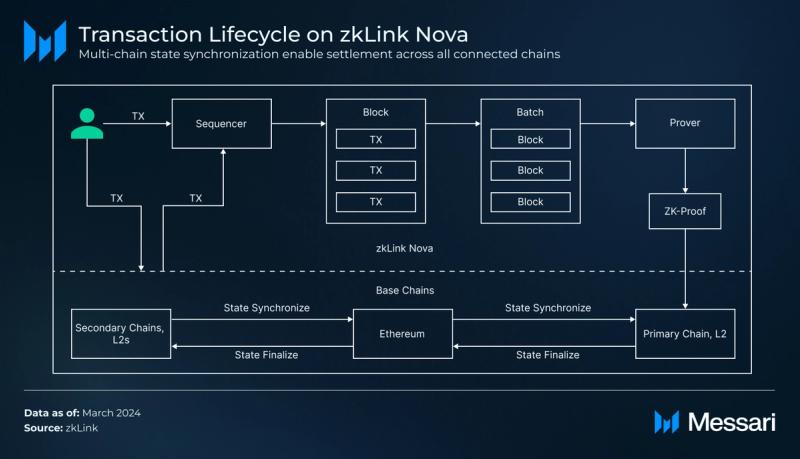
Building a multichain rollup introduces the risk of deposit fraud. A malicious sequencer could report a fake deposit on a secondary chain to the primary chain, potentially resulting in the loss of user funds.
To mitigate this, the state synchronization phase includes an extra transaction verification layer beyond the standard ZKP verification process employed in typical ZK-rollups. This added layer confirms that the real-time data submitted by the sequencer to the primary chain corresponds with the sync hashes periodically transmitted by secondary chains. Once verification is complete, the primary chain allows for settlement, leading to soft finalization. Then the batch roots are distributed to secondary chains for withdrawal processing, thus securing the network against fraud.
Data Availability
Transaction and state transition data are accessible on the data availability (DA) layer. As of writing, zkLink operates as a Validium, storing transaction data offchain with a Data Availability Committee (DAC). The DAC maintains a copy of the L3’s transaction data and its state history, storing transaction data cost-effectively, especially for ZK-rollups that also incur proof verification costs. However, DACs do not offer as much security as external DA solutions that are secured by specialized DA networks. Hence, zkLink Nova intends to leverage external DA solutions like Celestia and EigenDA in the future.
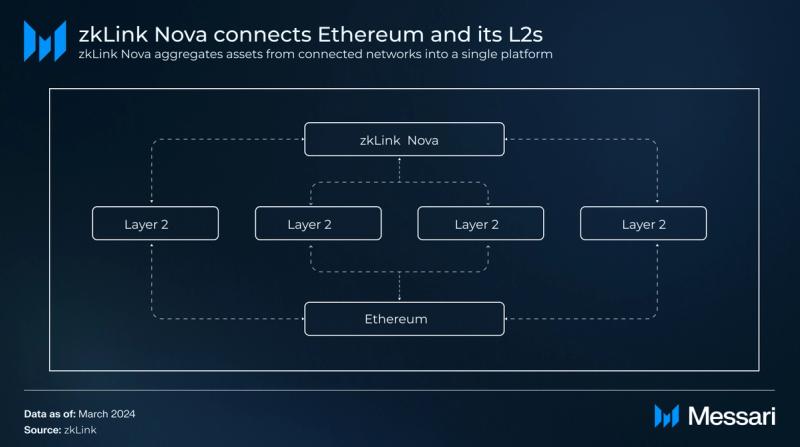
Asset Aggregation on zkLink Nova
To access zkLink Nova, users must first bridge assets from Ethereum and other connected L2s to the L3 via a canonical rollup bridge. Once on zkLink Nova, assets can be aggregated for interoperable transactions. Tokens of identical value from different networks can be merged into a single token to consolidate liquidity. zkLink Nova leverages zk-SNARKs and zkLink Nexus (multi-rollup state synchronization) to securely aggregate assets from all the connected networks. These features enable users to deposit and bridge:
- ETH from various connected networks to the L3. A unified native asset enables withdrawals without third-party bridges similar to withdrawals from a centralized exchange but without the counterparty risk.
- Native assets of other L2s, (e.g., ARB from Arbitrum) to the L3. This allows for interoperable trading of native L2 assets on Nova, enhancing capital efficiency and enabling new DeFi use cases.
- Stablecoins issued on different networks into a single stablecoin on the L3, simplifying the use of stablecoins while minimizing gas fees.
Merging Tokens on zkLink Nova
Assets of the same value and kind on multiple L2s have different token addresses. For instance, ETH bridged from Arbtrum and Optimism to zkLink Nova has two unique addresses. For users to interact with ETH bridged from both networks as a single asset on the L3, both unique assets must be merged into one.
To address this issue of asset non-uniformity, zkLink Nova employs an upgradeable token merge contract governed by a Governance Committee and a Security Council. This contract allows it to merge tokens of the same value into one token. Users bridging similar tokens with different addresses from multiple networks can lock source tokens via the token merge contract on origin chains to receive a derivative equivalent to the locked asset on zkLink Nova. Conversely, users can redeem locked tokens by burning the derivative equivalent via the token merge contract. However, the protocol imposes a deposit cap on supported assets, and source tokens can be locked via governance as a safeguard measure.
Changes to the token merge contracts are introduced and implemented via its governing bodies: the Governance Committee and the Security Council. These changes may include but are not limited to:
- Upgrades to the token merge contracts
- Adding merge support for a source token
- Changing the deposit cap for a supported asset
- Locking or unlocking a source token on the origin chains
While the Governance Committee initiates and votes on proposal upgrades to the token merge contract via a 2-of-3 multisig, the Security Council retains the right to veto such proposals. The Security Council ultimately oversees the operations of the Governing Committee and reserves the right to implement low-risk upgrades to the token merge contract.
zkLink X
zkLink X is an application-specific engine for deploying high-performance applications (e.g., financial applications like AMMs and DEXs) across multiple networks. Interoperability between different L1s and Ethereum L2s continues to improve with the emergence of cross-chain bridging solutions attempting to connect these networks. Yet, users are still faced with the challenge of moving and managing assets across these diverse networks with different technology stacks and tooling. Similarly, developers must deploy applications on multiple networks with different execution environments that sometimes require technical knowledge of diverse programming languages and tooling infrastructure.
zkLink X streamlines the dApp development process and offers developers a unified point for deploying applications with access to extensive liquidity across multiple networks. It enables dApp users to easily access, trade, and manage their assets across L2s and L1s through a single capital-efficient platform. zkLink X is a modularized deployment solution that allows developers to easily customize App Rollups across execution, settlement, DA, and sequencing layers for diverse application needs. Hence, developers can deploy high-performance applications and customize the above components by:
- Leveraging decentralized sequencers like Espresso, Astria, and Fairblock.
- Executing transactions using zkLink’s proprietary Trading Specific zkVM, designed for high-performance financial products like CLOB, AMMs, and DEXs.
- Settling transactions to either of zkLink X’s proprietary settlement frameworks: Nexus or Origin. With Nexus, transactions can be settled on Ethereum and its L2s, whereas Origin enables settlement on alternate L1s like Avalanche or Solana. Additionally, Nexus verifies the transaction state across all connected L2s with multichain state synchronization, while Origin verifies the same across all connected L1s and L2s via a Light Oracle Network.
- Utilizing external DA solutions like Celestia and Eigen DA to store transaction and state data.
One notable application-specific rollup built leveraging zkLink X is ZKEX, a decentralized exchange with aggregated liquidity from alternative L1s like BNB Smart Chain and L2s like Starknet. Users can trade multichain assets from supported networks on the application without having to bridge multiple assets. Users also enjoy a streamlined user experience as they can deposit these multichain assets into the DEX from a single self-custodial wallet (e.g., MetaMask).
Tokenomics
zkLink’s native token, ZKL, is scheduled for a 2024 release, although a definite release date has yet to be announced. ZKL will grant users access to zkLink’s rollup infrastructure service and grant tokenholders governance over the zkLink project. The asset’s planned functions include:
- Staking: Provers will stake ZKL to access zkLink’s proof generation market, where dApps request proof generation services. Subsequently, provers can earn ZKL rewards for completing these tasks.
- Payments: ZKL will be the primary payment token for zkLink’s proof generation market. dApps leveraging zkLink’s rollup infrastructure will pay provers in ZKL for ZKP generation services. Also, application-specific rollups built using zkLink’s rollup infrastructure will pay infrastructure fees in ZKP to zkLink DAO, the project’s proposed governance organization. These dApps may also adopt ZKL for fees used to pay for specific in-app offerings.
- Governance: Through a future zkLink DAO, ZKL tokenholders will exercise governance rights over the direction and development of zkLink.
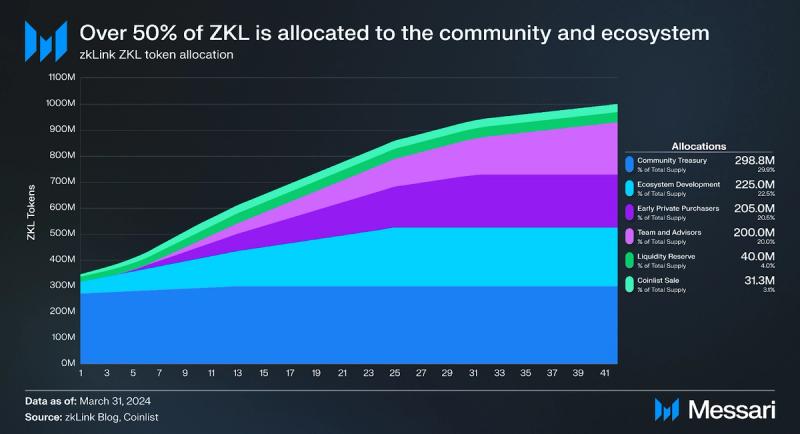
ZKL will launch with a maximum token supply of 1 billion without inflation. The token’s allocation is as follows:
- Community Treasury (~29.88%): The community treasury governed by the future zkLink DAO will control the most significant portion of the total token supply. About 20.75% of this allocation will be released at TGE and distributed as rewards to early adopters and as community development and bug bounty rewards to contributing developers. An additional ~9.37% reserved for bug bounties will vest monthly over a year. The remaining ~79.25% will be distributed in the future at the discretion of the DAO.
- Ecosystem development (22.5%): Dedicated to ecosystem development and will be used to fund growth initiatives and development programs. Of this allocation, 20% will be released at TGE, while the remaining 80% will vest monthly for two years.
- Early Private Purchasers (20.55%): To be distributed to private investors across all funding rounds. About 38.93% of this allocation is reserved for pre-seed inventors and is subject to a 5-month lock-up, and a 27-month linear vesting schedule. Another ~37.98% of this allocation is reserved for seed round investors and is subject to a 4-month lock-up and a 27-month linear vesting schedule. The remaining, ~22.87% is reserved for private round participants and is subject to a 3-month lock-up and a 27-month linear vesting schedule.
- Team and Advisors (20.00%): For the project team operating as zkLink Labs and the project’s advisors. This allocation is subject to a 6-month lock-up and a monthly linear vesting schedule for 3 years.
- Liquidity Reserve (4.00%): Will be locked in a liquidity pool at TGE. 50.00% of this allocation will be released at TGE and a monthly linear vesting for a year.
- CoinList Sale (~3.13%): For zkLink’s CoinList Community Sale participants. 30.00% unlock of this allocation will be released at TGE, followed by a 9-month linear vesting.
Aggregation Parade
Shortly after its mainnet launch in March 2024, zkLink Nova unveiled the Aggregation Parade in partnership with multiple Ethereum L2s (Arbitrum, zkSync, Manta, Mantle, and Linea). The program aims to boost ecosystem participation on zkLink Nova, rewarding participants with NOVA points (NP) for performing the following operations on the L3:
- Bridging: Users must deposit a minimum of 0.1 ETH from supported L2s to the L3 to accumulate NPs and receive a soul-bound token (SBT). Early deposits attract additional points.
- Participating in zkLink’s NFT referral program: Users can refer three other users to the L3 to receive one of four unique trademark NFTs.
- Upon acquiring all four unique trademark NFTs, users can upgrade initially awarded SBTs to a Nova Lynks NFT. Nova Lynks NFT holders qualify for a share of a community pool allocated 10 million ZKL.
- Staking: Users can stake supported assets like ETH, wBTC, USDC, other L2 tokens, liquid staking tokens, and liquid restaking tokens on the network to accumulate NPs. Staking points are accrued based on a token class multiplier schedule, group staking milestones, and an early bird bonus multiplier for early staking participants.
Since its mainnet launch in early March 2024, zkLink Nova has attracted over ~$300 million in TVL, signaling a growing demand for a unified general-purpose L3 platform.
Ecosystem
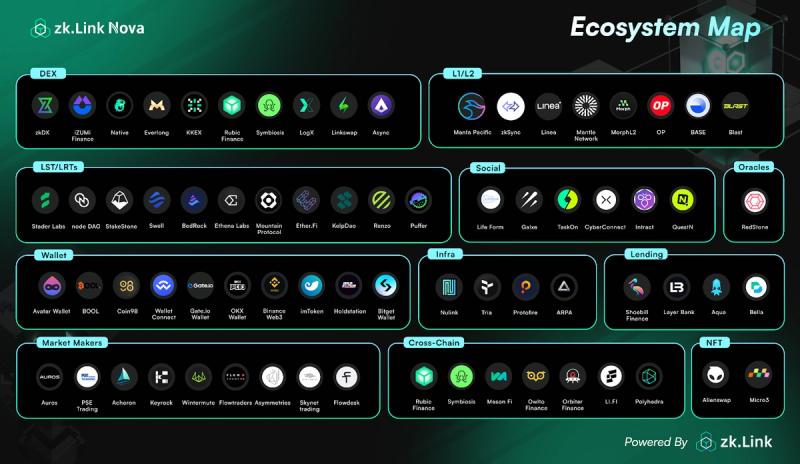
Source: zkLink Nova “X”
As of writing, there are over 60 projects within zkLink Nova’s ecosystem across DeFi, tooling, social, gaming, and NFTs. zkLink Nova continues to promote ecosystem participation through rewards and grants programs and initiatives that support developers, users, and L2s deploying on the L3.
Upon TGE, earlier ecosystem participants will be rewarded ZKL tokens based on a loyalty points system introduced in August 2023. zkLink Labs also introduced the Liquidity Alliance Program in December 2023, partnering with market makers like Skynet, Asymmetries, EF, Keyrock, Wintermute, Selini, and Flowdesk to supply liquidity to DeFi applications on zkLink Nova. In return for providing liquidity, market makers will also share an undisclosed portion of ZKL’s total token supply.
On March 8, 2024, zkLink Labs announced its developer grants program. The program will support the development of applications on the L3, focusing on DEX-AMMs, lending platforms, data indexers, oracles, bridges, and yield optimizers, among others. zkLink Labs set aside 20 million ZKL (2% of the total token supply) for the grants program, and each successful applicant will receive a maximum of 50,000 ZKL in grant awards.
To encourage ongoing research in advancing L3 development, zkLink periodically hosts L3 Summit events uniting L2s and other blockchain infrastructure projects within the Ethereum ecosystem. As of writing, zkLink has successfully concluded two L3 Summits, with the inaugural event debuting in November 2023 and the most recent in February 2024. These summits have seen participation from prominent L2 and infrastructure teams like Arbitrum, Celestia, EigenLayer, Kakarot, Linea, Polygon zkEVM, Manta, Mantle, Polygon, QED, Scroll, Starknet, Taiko, and zkSync.
Network Activity
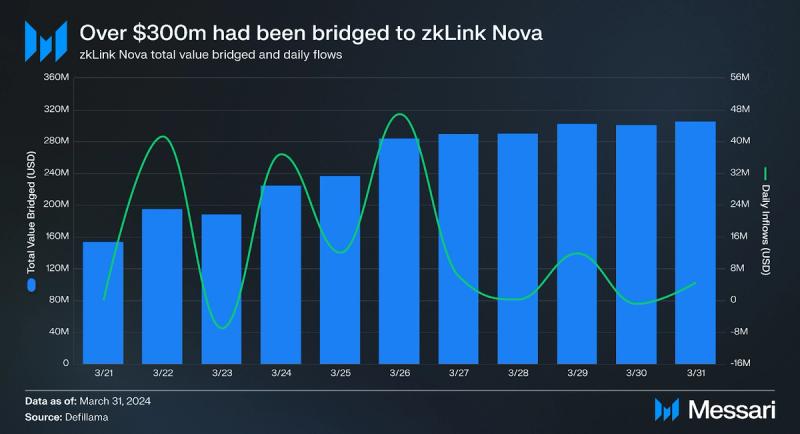
On March 14, 2024, zkLink Nova launched the Aggregation Parade, a points campaign to reward users who bridge various tokens to zkLink Nova with NOVA points. Various tokens including ETH, staked ETH tokens, USDC, and USDT are all eligible for NOVA points. The campaign has been a success, and $305.5 million has been bridged to zkLink Nova through March. According to DefiLlama, zkLink Nova is the largest L3 network by total valued bridged (TVB).

Activity has been steadily increasing on zkLink Nova since its mainnet launch on March 11, 2024. Daily transactions and daily active addresses both peaked on March 20, 2024, at 23,500 and 11,900, respectively. Throughout March, zkLink Nova averaged 4,800 daily transactions and 1,800 daily active addresses.

Due to the recent launch of zkLink Nova, DeFi TVL is still low. However, as more protocols are deployed, it should continue to increase. There are currently four protocols with notable shares of TVL: Symbiosis, Native, LayerBank, and iZiSwap. In total, the four protocols have a combined TVL of $1.4 million. The largest protocol is Symbiosis, with a 46% share of TVL ($652,200). The only lending protocol to date, LayerBank, has a $200,500 TVL, representing 14% of DeFi TVL on zkLink. As more protocols continue to deploy on zkLink, it is expected that an increasing amount of the value bridged to zkLink will be utilized in DeFi.
Competitive Landscape
Prevalent L2s like Arbitrum, Optimism, Taiko, and zkSync, among others, are building interoperable scaling solutions to address Ethereum’s fragmentation challenges. For instance, Arbitrum’s Orbit development stack allows developers to deploy customizable and interoperable L2s or L3s known as Orbit Chains. Optimism’s Superchain aims to create a unified network of interoperable OP Chains that share a standardized tooling and development stack (OP Stack). zkSync’s HyperChain approach connects interoperable but parallel instances of the zkEVM stack with a shared bridge contract and a unified settlement on Ethereum via proof aggregation. Yet, the diversity of their underlying technology stacks limits interoperability between the Arbitrum and Optimism ecosystems. Taiko is building a Type 1 zkEVM for deploying L2s and L3s that can execute Ethereum code seamlessly without any modifications. Despite the potential for enhanced EVM compatibility with Ethereum, developers may need to be sufficiently motivated to switch from established L2 ecosystems like Arbitrum or Optimism to Taiko.
Conversely, zkLink adopts a universal approach that consolidates all L2s and L1s, regardless of the underlying technology, onto a single platform. zkLink Nova’s L3 streamlines access to liquidity and development across all L2s into a single platform. At the same time, zkLink X allows for the deployment of customizable application-specific rollups with support for L2s and alt-L1s. Omni Network is another project that aims to unite Ethereum L2s. Although, unlike zkLink, Omni Network is an independent L1 that relies on ETH restaking for its security as the first actively validated service (AVS) live on EigenLayer. While zkLink Nova and Omni Network launched in March 2024, analyzing each protocol’s approach to aggregating L2s could help determine if an L3 is well-positioned to address Ethereum’s fragmentation challenge instead of an independent L1.
Critics have argued that L3s do not necessarily provide much value in scaling Ethereum, citing security risks since most L3s settle on L2s and still need to be interoperable. However, others have argued that L3s scale Ethereum by enabling customizable application development, which may not be possible on L2s. Beyond scaling, L3s like zkLink Nova offer a unified execution environment for developing applications on Ethereum since zkLink Nova ultimately settles on Ethereum and its L2s. As such, users and developers can enjoy an improved user and developer experience without leaving Ethereum for other L1s.
Roadmap
zkLink Nova’s alpha mainnet launched in March 2024, and substantially new upgrades to the L3 will include support for external DA solutions, a decentralized proof auction market, and the release of new proof systems. Regarding zkLink’s centrally managed sequencer service, the team plans to integrate decentralized solutions like Espresso, Astria, and Fairblock in the future to mitigate centralization risks. Another anticipated upgrade is the ZK Oracle, a light node oracle network validating cross-chain states as part of zkLink X’s application-specific engine.
As of writing, zkLink operates as a Validium, storing transaction data offchain with a Data Availability Committee (DAC) although the ultimate goal is to support external DA solutions like Celestia and EigenDA in the future.
Closing Summary
As Ethereum’s ecosystem grows more complex with the incremental launch of new L2s, solutions like zkLink and its L3 are crucial for streamlining the user and developer experience on the L1. Moreover, the rise of alt-L1s further fragments the blockchain landscape underscoring the need for capital-efficient multichain applications. zkLink aims to address these fragmentation challenges with zkLink Nova, its general-purpose L3, and zkLink X, its customizable application-specific scaling engine. Since launching in early March 2024, zkLink Nova has attracted over $300 million in TVL, highlighting an emerging interest in a unified, general-purpose L3 platform. ZKEX has also been deployed on V2 Alpha Mainnet as the first application-specific DEX built with zkLink X. While other projects race to solve Ethereum’s fragmentation challenges, zkLink’s development roadmap focuses on building the leading hub for a unified user and developer experience across Ethereum L2s and alternate L1s.

















